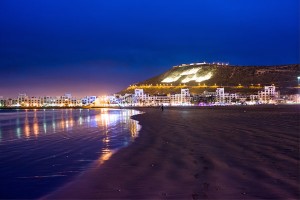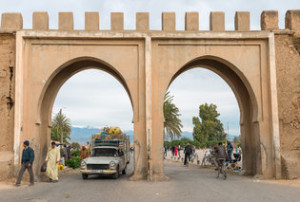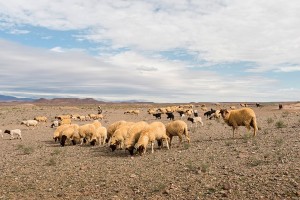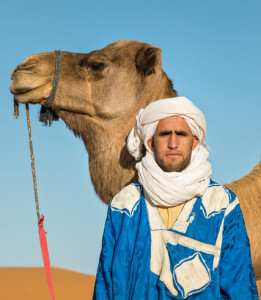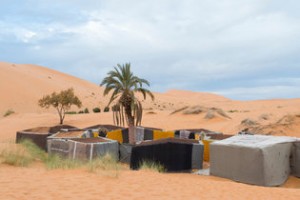New York Times
by Seth Sherwood
From Agadir to Merzouga Scenes from across Morocco.
The temperature was easily 90 degrees as Mohamed wrapped my head with a long blue chech, the sun protection worn by Moroccan desert nomads. Nearby, camels snorted and moaned while handlers outfitted them with saddles for the imminent journey. Behind us loomed a long two-story dune and an ocean of sand, undulating toward the vanishing point. After a weeklong voyage across southern Morocco, I was about to venture at last into the Sahara, the culmination of a personal two-decade dream.
“Water?” asked Mohamed, the young manager of my hotel, pointing at the tote bag containing my provisions: an orange, a toothbrush and, yes, a bottle of water. The supplies suddenly struck me as recklessly meager.
I awaited parting counsel about sun protection, desert navigation, survival tactics and worst-case scenarios, but Mohamed just smiled. A spring breeze had picked up, conjuring a paranoid thought.
“There’s no risk of sandstorms?” I asked. “They start in summer, right?”
“No, they start around now,” he said with a grin. Then he walked back into the hotel, leaving me with a teenage guide.
I tried to laugh off the remark. After all, this was only the world’s largest desert, a relentless world of sun and scorching sand some 3.5 million square miles in size, where you might stagger directionless for days or weeks in lethal heat without glimpsing any human or animal life, save perhaps a scorpion. What was the worst that could happen?
The Saharan winds first blew through my life 20 years ago when I was in graduate school. They stirred from the pages of “The Sheltering Sky,” Paul Bowles’s existential 1940s novel of the unraveling lives of three Americans traveling in the North African desert.
From the first words I was enthralled and unnerved: “He awoke, opened his eyes. The room meant very little to him; he was too deeply immersed in the non-being from which he had just come. ” Elegiac sentences carried me along paths as wondrous as those tread by the novel’s nomads, who voyage ever deeper into the indifferent desert. “She was struck by the silence of the place,” Bowles writes of Kit, who is traveling with her husband, Port. “She could have thought there was not a living being within a thousand miles. The famous silence of the Sahara.”
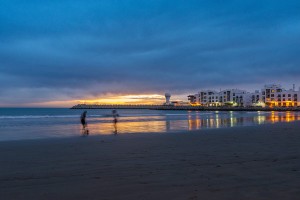
Khalid and Zakaria, local students, play soccer on the beach at Agadir.
MALÚ ALVAREZ FOR THE NEW YORK TIMES
The famous silence of the Sahara. The phrase echoed. I ended up writing my master’s thesis on the strange fiction of Bowles’s wife, Jane, a model for Kit. (Jane and Paul Bowles were based for decades in the Moroccan port city of Tangier until their deaths in 1973 and 1999.) In the succeeding years, I nurtured the same dream as the sheltered mountain girls whose tale forms the thematic filament of “The Sheltering Sky”: to visit the desert, to climb the highest dune, to drink tea in the Sahara.
Last March the moment arrived. Having explored Marrakesh, Fez and Casablanca on previous visits, I headed to the expansive rural south, a region of less human density and vaster perspectives.
Aboard CTM and Supratours bus lines, I journeyed across the sparse mountain and canyon landscapes of the Berbers, the fair-skinned inhabitants of North Africa who predate the seventh-century Arab invaders and still compose most of southern Morocco’s population.
From Atlantic shores to Saharan dunes, the seven-day journey turned up towns both fascinating and forlorn, a kaleidoscope of centuries-old souks, dusty colonial-era outposts, livestock markets and luxury restaurants where I tried everything from French foie gras to Moroccan wine. In one town I found a strange cinematic world of biblical episodes, Buddhist masters and James Bond villains. At nearly every stop, I encountered the ghost of Bowles himself.
Agadir
After landing in Marrakesh, I took a three-hour bus ride to Agadir, a coastal getaway of modest beaches, golf courses and resorts. Mine, a clean white Moorish-modern complex called Kenzi Europa, seemed especially popular with Northern European vacationers who fly into Agadir’s international airport on budget airlines and crowd the swimming pools of all-inclusive retreats.
Knowing Agadir would be my last chance to indulge in the beach, fresh seafood and any semblance of conventional night life, I set out for a quick pampering before the privations of the hinterlands. The main drag, Boulevard 20 Août, obliged my first need, leading between slightly dingy white concrete buildings (erected after an earthquake in 1960 decimated the city) to the Atlantic shoreline.
Under the late-afternoon sun, the Moroccan middle-classes — mustachioed men, shrieking children, women in long, colorful caftans — strolled among those familiar characters and rituals that unite the world’s beach boardwalks: the guy twisting balloon hats, the line for ice cream in waffle cones, the teenage boys showing off break-dancing moves for local girls.
Agadir might have been South Florida or South Texas but for the women in headscarves, the Arabic signs (including one for “McDonald’s”), and the sprinkling of words in French, which is widely spoken across Morocco (I used it for daily transactions).
Twenty-five dirhams netted a sun bed at Chez Aziz, a beach club. Forty-five more yielded a cold Casablanca beer. A lone sea gull wheeled against a powder blue sky as the waves crashed, dissolving all sense of time.
Come nightfall, the city’s marina, a complex of white Spanish-Moorish buildings housing Zara and Mexx boutiques, served up the second stage of pampering at Le Quai restaurant. Sunk in a white leather banquette, I slurped foie gras-topped oysters while listening to two strolling guitarists strumming an Andalusian adaptation of Dave Brubeck’s “Take Five.” A lively group of Moroccan women with slim leather jackets applauded in between drags on cigarettes and sips of cocktails. The whole scene paired perfectly with Domaine de Sahari, a Moroccan vin gris (a light rosé) whose name evoked the endpoint of my journey.
Taroudant
A morning bus carried me across scraggly plains dotted with skeletal trees and mud-brick shantytowns. Two hours later in Taroudant, I found a maze of narrow lanes lined with low, worn buildings. Veiled women and men in djellabas drifted past the rows of halal butchers, bicycle repair stalls and machine shops. A cacophony of noises resounded: buzzing cheap scooters, honking taxis, clip-clopping horse carts, radios blasting Moroccan pop.
So this, I mused, was La Petite Marrakesh, as Moroccans have nicknamed Taroudant, mostly for the history it shares with its gaudier, more famous cousin to the north. Taroudant, and later Marrakesh, served as the capital of the Saadians, one of the powerful Arab dynasties that fought for control of Morocco in the 16th and 17th centuries, and both cities retain timeworn crenelated ramparts, labyrinthine souks and lively central squares populated with folk healers and snake charmers.
The similarities appeared to end there. Taroudant felt pleasantly devoid of the luxury sheen and global brands that crowd Marrakesh. No five-star hotel chains, no Club Med, no fashion shoots and no casinos greeted me here.
Nor did many travelers. I glimpsed few in the outdoor Sunday market beyond Taroudant’s walls. Passing under a keyhole-shaped gateway called Bab El-Khemis, I came across a dusty field filled with piles of mismatched shoes, cheap kitchenware, children’s clothes, sundry produce and electronic parts along with fresh-squeezed orange juice (five dirhams a glass). A woman proudly swung a new scythe, almost harvesting a few customers in the process.
If you, like me, missed the cinematic release of “Dim Sum Funeral” and “Son of Rambow,” [sic] the DVDs await in Taroudant’s Sunday market. So does livestock. Sharing a motorcycle, two men rustled off a small goat, upside down, its eyes blinking in confusion. A three-wheeled utility vehicle sputtered by with a small payload of sheep. A salesman saw me eyeing his goat and grinned.
“Miyya dirham!” he bellowed in Arabic. (“A thousands dirhams!”)
Essential advice: always haggle.
The skill proves useful in Place el Alouine, the central square where buskers strum long-necked lotars and healers promote their wares. One afternoon I observed a man swinging a cobra and shrieking in Arabic to amazed onlookers. Across the square, a Berber band strummed and fiddled strange instruments, conjuring cosmic rhythms. Between them, an African man in a skullcap sat on a blanket covered with the vacant skulls, blackened bones and bowling ball-size eggs of dead ostriches.
“It’s medicine for the stomach,” he said of the eggs. Then he handed me a plastic bottle whose label was written in French. For “Frigidité sexuelle,” it read. “Remede de Testicules.”
I politely declined, saving my bargaining skills for the covered lanes of stalls that form Taroudant’s souks. My proving ground was Chez Brahim, filled with colorful boxes and bowls made from tadelakt, a lime plaster polished with black olive-oil soap for a smooth finish, and silver jewelry inlaid with red coral, turquoise, malachite, jade and other stones.
“We find these among the mountain people, who wear them for their wedding day and then sell them to us when they need money,” said Brahim, the owner, who humored my haggling attempts with the amused countenance of a father watching a child eat his first ice cream cone.
“It used to be the Jews who made them, and the artisans who make them now are following the Jewish tradition,” he said, explaining that the city once had a thriving Jewish minority. “They’re gone, but we still have the synagogue and the cemetery, with stones written in Hebrew.”
He showed me the adjacent Mellah, the old Jewish quarter. No trace of the neighborhood’s original character or inhabitants remained. Inside a doorway marked “Riad Argane,” I found two middle-aged Berber women sitting on stools and turning grindstones.
A young Moroccan man explained in excellent English that the women were crushing nuts from argan trees into an extract that would become oil. In fact, he said, Taroudant province supplies nearly half of Morocco’s argan oil, used for cooking and skin care. The women were part of a nationwide antipoverty program that employs widows and divorcées.
“It’s changed many women’s lives by giving them financial autonomy,” said Mohamed Zeroual, who expressed surprise at meeting an American in Taroudant. “Americans normally stick to the big cities, Marrakesh, Fez, Tangier.” He mused over that last word. “Have you ever read the American writer Paul Bowles?” he asked.
“I am here because of ‘The Sheltering Sky,’ ” I answered, amazed. “I’m headed to Merzouga to see the desert.”
“Ah,” he said with a nod before slipping into French. “Merzouga, c’est bien.”
Ouarzazate
Beyond Taroudant the landscape became a world of stone, sand and scrub with the jagged summits of the Atlas Mountains in the distance. Geological curiosities — huge spilled guts, oversized sand-drip sculptures — rushed past. A switchback climbed high ridges and descended into a valley dotted with one-street towns. Then the barren plains resumed.
Suddenly, four hours after leaving Taroudant, the bus was coasting along urban streets lined with shiny new cars, ocher buildings, wrought-iron lampposts and functioning fountains. Built by the French colonists in the 1920s as a garrison town, the city of Ouarzazate radiated an orderly European feel. Only the city’s sprawling old fortress, a Babel-like jumble of towers and battlements called Kasbah Taourirt, broke the modern aura.
Along Boulevard Mohammed V, the main drag, tour companies trumpeted day trips to valleys, gorges, oases, mountains, fortresses, perched villages, desert expanses and other breathtaking spots that draw rugged travelers to this quiet backwater.
They also draw a more rarefied flock: international film directors. Thanks to these dramatic landscapes, the regions around Ouarzazate have starred in dozens of movies. If you have seen “Lawrence of Arabia” (1962), “The Man Who Would Be King” (1975) or “Alexander” (2004), then you have already been introduced to the area.
For my own introduction, I dined at a stylish French-owned restaurant, Accord Majeur, with Hanane Alami, the aunt of a friend in Paris. Employed by a Moroccan film production company, she was in town to organize a shoot, still hush-hush, for a project about “ancient Egypt” in partnership with 20th Century Fox. Over steak au poivre, she recalled the celebrities she had worked with in Morocco — Robert Redford, Mira Sorvino, Prince — and intimated that the grand hotel across the street, Le Berbère Palace, is favored by film crews and stars.
An even more cinematic dinner awaited at Chez Dmitri, the city’s oldest restaurant. With its black-and-white checkerboard floor, white tablecloths, wooden venetian blinds and vintage wooden radio, the restaurant seemed unchanged since it opened in 1928. Photos of former clients like Ben Kingsley, Gérard Depardieu, Orson Welles and John Malkovich peered out from the walls. Delivering my goat cheese on toast, the waitress intimated that Juliette Binoche had dined there recently.
I asked about Mr. Malkovich, who starred in Bernardo Bertolucci’s 1990 film version of “The Sheltering Sky.” The restaurant’s owner, Pierre Katrakazos — he inherited the restaurant from his father, the namesake Dimitri — said that the actor visited during the shooting. So had Bowles himself.
“A small man with white hair, accompanied by his driver in an old Ford Mustang,” Mr. Katrakazos recalled. “He spoke an excellent French with a few words of English mixed in, like a typical American.”
Bowles wanted to chat with Dimitri, whom he had befriended while passing through decades earlier. Mr. Katrakazos explained to the writer that his father had died. Bowles uttered an English expletive and left.
Local bus No. 1 took me a few miles out of town to Atlas Studios, the place where much of the cinematic magic happens. Led by our guide, Aziz, my tour group walked past a fake fighter jet from the 1980s comedy-adventure film “The Jewel of the Nile”; a Tibetan pagoda-like building from Martin Scorsese’s biopic of the Dalai Lama, “Kundun”; and through an ersatz ancient village that had figured in “Gladiator.”
Leading us through a phony Egyptian temple used in “The Mummy,” Aziz pointed at a far-off fake castle set dramatically before real mountains. “That castle was used for ‘Kingdom of Heaven’ and then again in ‘Game of Thrones’ Season 3,” he said.
Turning a corner, we found scores of local men equipped with shields and spears. A boss barked military marching orders as Europeans with clipboards looked on. Martin Werner, a tall, bald Dane and the project’s director, explained that they were preparing a Roman battle scene for a Swiss Telecom commercial.
“This is a legendary location,” he said. “We can benefit from what’s been done before, like that castle built by Ridley Scott. Plus we need horses and a thousand soldiers. All of that is possible here.”
Best of all, he said, was the natural light. “It’s incredible,” he said. “Stunning. It’s crisp and clear and golden.” Then he turned serious. “The only big enemy here is a potential sandstorm,” he said. “You never know. It can happen over a period of an hour. Nobody can predict it.”
Merzouga
With those unsettling words in mind, I rode for eight hours the next day in a nearly empty bus toward my final destination, Merzouga. My fellow travelers included three young Chinese men and a German couple. All of us, it seemed, were inspired by the same fantasy: to reach the end of the road, where asphalt turns to sand.
We darted through the bucolic Dadès Valley, past fortresses and settlements where tumbledown roadside stalls sold local roses. Soon the bus was a floating shadow against a wasteland of undulating rock, red Martian expanses and crumbly mesas.
I fell asleep and woke much later as we cruised alongside a wide riverbed. Night had fallen. The moonlight illuminated not water but dense groves of trees that filled the deep channel, an almost miraculous bloom of green life. An hour later we finally stopped in the village of Merzouga.
“Monsieur Sherwood?”
Two men in long robes explained that my hotel had sent them. In a subcompact car we rattled down unpaved streets until we reached Ksar Bicha, a sand-colored fortresslike complex. The manager, Mohammed, welcomed me, led me to a second-floor balcony and pointed into the night.
“Tomorrow, when the sun comes up, you will see the dunes,” he said. “They are right next to us, just beyond the wall.”
Indeed they were. I woke at dawn to the snorts and shouts of camels and their handlers, just outside the hotel grounds. Beyond them there was only sand.
That afternoon, Mohamed tied the chech around my head and helped me and another guest mount our camels. Then he vanished. A teenage boy named Said, dressed in a blue robe, led our two-camel train into the dunes.
The desert quickly makes friends of strangers. The other rider, Conor Power, a 24-year-old Irishman, and I filled the quiet with chatter about e-commerce (his field), the Edward Snowden affair, favorite spots in Istanbul, “House of Cards” and, inevitably, emergency desert survival.
“I heard that you can put a plastic bag over one of these small desert plants, place a saucer underneath and drink the condensation that accumulates,” he said. “Unfortunately I’ve forgotten my plastic bag and saucer.”
Like boats, we buffeted up and down the waves of sand to the rhythm of the camels’ thudding feet. I asked Said my camel’s name in rudimentary Arabic. He told me that camels don’t have names.
“I will give him one now!” he declared. “What about Bob Marley?”
And so, after a few hours, Bob Marley led me into the hotel’s desert camp, a rectangular arrangement of boxy tents made from carpets and blankets. Behind them soared a reddish dune. I dismounted, threw my pack in a tent and ran up the escarpment, slipping and stumbling in the powder.
Staggering upward, I reached a flat landing after 30 excruciating minutes. I had conquered only half the dune but felt a rush of satisfaction as I panted. Above, the summit’s silhouette cut a shadow against the low-slanting sun. Before me, a panorama of golden desert spread in all directions. No threat of sandstorm was visible on the horizon, only a long plateau of rock: Algeria.
“The desert landscape is always at its best in the half-light of dawn or dusk,” Bowles wrote. “The sense of distance lacks: a ridge nearby can be a far-off mountain range, each small detail can take on the importance of a major variant on the countryside’s repetitious theme.”
Near nightfall I slid back down to camp. Jagged stars blazed overhead, like a van Gogh painting. An employee in a djellaba approached with a silvery pot. After a week crossing Morocco, my two-decade dream was realized: tea in the Sahara.
Seth Sherwood, based in Paris, is a frequent contributor to the Travel section.





